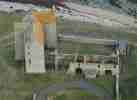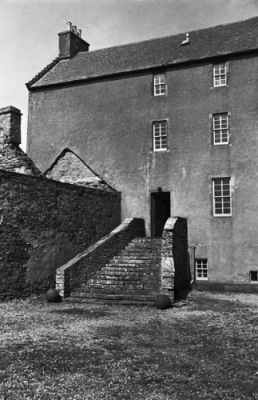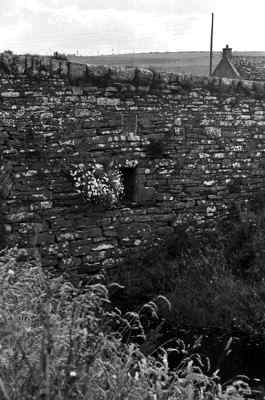| Freswick Castle, Caithness Map Ref: ND 3780 6714 Parish of Canisbay |
Freswick Castle From The Air Freswick Castle The name is found as Fraswiln, Frecsyk, Frescewik, Freschwik, Fresch-wyck, Freshweik, Fresh Wyk, Freswic, Fresik, Freswike, Fressick, Fresyck, Thrasvik, Trasvik, etc. Also known as the fortalice of Burnside at Freswick, Freswick Tower and, latterly as Freswick House, the name is derived from the Norse Thrasvík, meaning the 'bay of fresh water', probably after the Gill or Freswick Burn which runs into the sea at Freswick Bay. It must not be confused with Buchollie's Castle (qv) which is at Kingansgeo three-quarters of a mile to the south, nor with the fortress of Lambaborg (qv) which is also close by. Its first holder to come to notice is Hallvardr or Havard of Freswick, who was brother-in-law and syslumadr, or steward to earl Sigurd the Stout of Orkney/Caithness. Hallvardr was slain in a blood feud in 1040 by the Scottish mormaors Crinan and Maelsnechti.
In the twelfth century Freswick seems to have been the site of one of Svein Asleifarson's longhalls. The estate seems actually to have belonged to his stepson Sigmund öngull Andresarson, and was purchased c.1141 with the money made by selling his deceased father's estates in the Isle of Man. The stewardship and control of the estate, however, was in Svein's hands. Svein Asleifarson, known as 'the last of all the Vikings', died at the siege of Dublin in 1171 and was succeeded by his son Andrs Sveinsson. Andrs (or Andrew) married Frida, daughter of Kolbein hruga, baron of Agdir in Norway and lord of Wyre Castle in Orkney. Their son, Gunni Andresarson, succeeded c.1190. He was a supporter of Harald ungi Eiriksson, whom William the Lion made earl of South Caithness in 1184. In 1198 a battle took place at Wick between Harald ungi and his rival Harald Maddadarson, Earl of Orkney and North Caithness. Harald ungi was slain and William the Lion was so incensed at the death of his protégé that he came north with a great army.
In 1231 Snaekoll and his kinsmen were tried and found guilty, some were beheaded but Snaekol was imprisoned in the royal castle of Bergen. Shortly after he was released into the guardianship of the King's father-in-law, Skuli Bardarson. Duke Skuli was plotting to take the throne from Hakon and with Snaekol he went north and reformed the warband known as the Wolfcloaks. Snaekol was made a captain or steward of the Wolfcloaks but was captured by Hakon's loyal guard, known as the Birchlegs, on the island of Borgholm in 1239. After the defeat and slaughter of the Wolfcloaks at the battle of Oslo in April 1240 Snaekol was executed. Snaekol was succeeded, probably by his brother, Andrs Gunnasson who made a visit to Iceland on earldom business in 1235. Following the Norwegian defeat at the battle of Largs in 1263 and the subsequent Treaty of Perth in 1266 there were significant changes made to the civil and military administration in Caithness. From this time until 1361 the ownership of the lands of Freswick is uncertain but it seems clear that they came somehow into the control of the earls of Ross. A charter of Earl Malise of Caithness confirming his daughter as his heir to the earldom was inspected on 12th May 1362. This daughter of Earl Malise was niece to William, fifth Earl of Ross, her mother being the earl's sister Marjorie, and in 1361 the latter had made a grant of the lands of Freswick, Auckingill and Harpsdale to his half-brother, Hugh Ross of Balnagowan. It was probably Hugh who built the castle or 'fortalice of Burnside' at Freswick which is mentioned in charters from the fourteenth century. In 1410 William de Montealto or Mowat of Loscragy gave a wadset of his lands of "Freswic et de Ockyngille" in Caithness to his son, John Mowat. It is unclear by what right the Mowats acquired Freswick but the grant was confirmed at Perth by Robert Stewart, Duke of Albany and Regent of Scotland in July that same year (vide Buchollie's Castle). Thereafter the estate of Freswick was held by successive members of the Mowat family until 1661 when it was acquired by William Sinclair, third Laird of Rattar (qv), a great-grandson of John, Master of Caithness. However, the ancient tower of Burnside at Freswick seems to have been held by a branch of the Sinclairs somewhat earlier, at least since 1580, though how this came about is still a mystery. The tower house of Freswick seems to have been refortified or enlarged about the year 1580 by George Sinclair, fourth Earl of Caithness. The tower was built on a spit of rock which juts out towards the sea and a channel was cut through the rock to isolate it for purposes of defence. The trench was originally spanned by a movable wooden bridge but this was later replaced by a permanent stone-built bridge, probably completed by the earl's grandson, Sir William Sinclair, in 1662. In 1635 the King granted the lands and lordship of Freswick together with the castle and manor there of Burnside to Roger Mowat of Drumbreck on a resignation of his kinsman James Mowat of Balquholly. The King confirmed a new grant of the castle to the same Roger Mowat in 1644. Mercator's map of 1595 lists it as "Freswick Castle" and it is marked on Mercator's Map of northern Scotland of 1636 but it is not clear whether this or Buchollie's Castle is meant. James Dorret's map of the 1760s notes it as "Freswick T." where the T probably stands for 'Tower' - perhaps a more appropriate and less confusing term for this building than 'castle'. In 1661 the lands of Freswick were held of the Crown in chief and included the lands of Auckingill, Tofts and Stroupster. The adjacent estate of Duncansby (qv) seems to have been incorporated into the Freswick estate at this time so that Sir William Sinclair held Rattar, Greenland, Duncansby, Freswick, Auckingill, Tofts and Stroupster, a veritable fiefdom. The original tower was probably enlarged by William Sinclair of Freswick in 1661-2 and became known thereafter as Freswick Tower and later as Freswick House. This William Sinclair married, 24th March 1661, Elizabeth, daughter of John Sinclair, first of Ulbster. William, first of Freswick was twice married and was succeeded by three of his sons in succession, these were James second of Freswick, who was one of the Commissioners for Caithness in 1678, he is said to have died in France; Robert third of Freswick, and David fourth of Freswick. The latter died in 1712 and was succeeded by his nephew William Sinclair, fifth Laird of Freswick, who further enlarged the building before his death in 1769. He married Janet, daughter of Patrick Sinclair of South Dunn by whom he had two sons, John and William of Rattar. John was a minor when he succeeded and the estate was controlled by his uncle, William Sinclair who was granted the courtesy title "of Freswick" as was the custom. In 1775 John Sinclair of Freswick executed a deed of entail and, dying young, the direct male line came to an end and the inheritance devolved upon William Sinclair Thomson Sinclair, a descendant of Barbara, sister to William Sinclair, fifth of Freswick. Some of the Sinclair lairds of the eighteenth century had the reputation of being oppressive. Their tenants were expected to turn over one piglet in three and every third lamb to the landlord as well as a share of anything caught by handline fishing and a proportion of the harvest. The lairds also had a bridge prison built crossing the Gill Burn of Freswick in which both thieves and recalcitrant tenants might find themselves locked up. Prisoners were dropped through a trapdoor in the road which crosses the bridge but this has now been closed up. Freswick Castle and its bridge prison were known locally as the 'House of Cruelty'!
There has been much discussion as to whether this building deserves to be called a castle, a tower, or a house, all of which designations have been used at various times in its history. Much of this confusion has arisen because there have been two successive caputs of the Freswick Estate, Buchollie's Castle and Freswick Castle. Suffice to say that the 1635 Great Seal charter granting this building to Roger Mowat of Balquholly describes it thus: "terras dominicales de Freschweik cum castro, maneriei locum de Burnesyde", or 'the lordship lands of Freswick with the castle, or manor there of Burnside'. The five-storey tower is accessed by means of an external stone stair-case leading to a first-floor entrance door. This is almost identical to the staircases once found at Barrogill Castle (qv), Thurso East Castle (qv) and Dale House (qv). Internally there is a stone spiral staircase which ascends to all floor levels. ND 3780 6714 Parish of Canisbay © 2003 Copyright M J Gunn. |

 The king forced Harald Maddadarson into submission and
made him pay a great fine. At the same time one of Harald ungi's sisters
named Ragnhild was married to Gunni Andresarson, whose posterity, the Clan
Gunn, acquired thereby large estates in Caithness. Gunni was succeeded by
his son Snaekol Gunnasson. In 1230 Snaekol, who was claiming part of the
earldom of Orkney in right of his mother, came with some kinsmen and
friends to Thurso and there killed Harald Maddadarson's son and successor,
Earl John. The killers then took ship to Orkney where they fortified and
provisioned Snaekol's great-grandfather's castle of Wyre. Here they
were besieged by the dead earl's kinsmen but the castle was strongly
defended and in the end all parties agreed to go to Norway to have King
Hakon settle their differences.
The king forced Harald Maddadarson into submission and
made him pay a great fine. At the same time one of Harald ungi's sisters
named Ragnhild was married to Gunni Andresarson, whose posterity, the Clan
Gunn, acquired thereby large estates in Caithness. Gunni was succeeded by
his son Snaekol Gunnasson. In 1230 Snaekol, who was claiming part of the
earldom of Orkney in right of his mother, came with some kinsmen and
friends to Thurso and there killed Harald Maddadarson's son and successor,
Earl John. The killers then took ship to Orkney where they fortified and
provisioned Snaekol's great-grandfather's castle of Wyre. Here they
were besieged by the dead earl's kinsmen but the castle was strongly
defended and in the end all parties agreed to go to Norway to have King
Hakon settle their differences. At the beginning of the twentieth century Freswick
House was the home of Admiral Sir Edwyn Sinclair Alexander-Sinclair, MVO,
Laird of Freswick and Dunbeath. At his death in 1948 the Freswick
Trust Estate assigned the property to Freswick Estates Company Limited.
The house passed through several hands including Dr. Bell who lived there
as a virtual recluse. In 1977 it was purchased by Captain Gerald Newell of
Staffa. He and his wife Enid began the difficult task of restoring the
castle to its former glory. In 1979, at the Newell's invitation, a team
from the Archaeology Department of Durham University began excavations at
Freswick which continued over several seasons. Colleen Batey and her
colleagues from Durham published some of their exciting findings in 1979,
1981, etc. Sadly, the Newell's hard work proved a severe drain on their
financial resources and they eventually sold the castle. It is presently
the home of Murray Watts, a film animator and producer of religious
cartoons, including the award-winning The Miracle Maker.
At the beginning of the twentieth century Freswick
House was the home of Admiral Sir Edwyn Sinclair Alexander-Sinclair, MVO,
Laird of Freswick and Dunbeath. At his death in 1948 the Freswick
Trust Estate assigned the property to Freswick Estates Company Limited.
The house passed through several hands including Dr. Bell who lived there
as a virtual recluse. In 1977 it was purchased by Captain Gerald Newell of
Staffa. He and his wife Enid began the difficult task of restoring the
castle to its former glory. In 1979, at the Newell's invitation, a team
from the Archaeology Department of Durham University began excavations at
Freswick which continued over several seasons. Colleen Batey and her
colleagues from Durham published some of their exciting findings in 1979,
1981, etc. Sadly, the Newell's hard work proved a severe drain on their
financial resources and they eventually sold the castle. It is presently
the home of Murray Watts, a film animator and producer of religious
cartoons, including the award-winning The Miracle Maker.